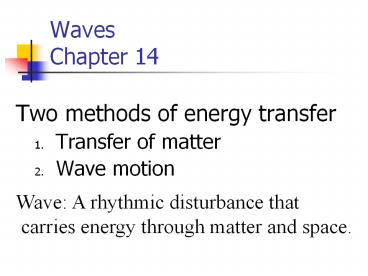Waves Chapter 14 - PowerPoint PPT Presentation
1 / 25
Title:
Waves Chapter 14
Description:
Waves Chapter 14 Two methods of energy transfer Transfer of matter Wave motion Wave: A rhythmic disturbance that carries energy through matter and space. – PowerPoint PPT presentation
Number of Views:150
Avg rating:3.0/5.0
Title: Waves Chapter 14
1
WavesChapter 14
- Two methods of energy transfer
- Transfer of matter
- Wave motion
Wave A rhythmic disturbance that carries
energy through matter and space.
2
WavesChapter 14
- Two types of waves
- Mechanical-Need a medium to which they transfer
energy - Electromagnetic-Do not need a medium to which
they transfer energy
3
WavesChapter 14
- Waves are also classified on how they transfer
matter - Transverse Waves-Causes the particles to vibrate
perpendicular to the direction of motion. - Longitudinal (Compressional) -Causes the
particles to vibrate parallel to the direction of
motion.
4
Wave Motion
5
WavesChapter 14
- Characteristics of Waves
- Wavelength (?) The linear distance between
corresponding points on corresponding waves. - Frequency (f) The number of wavelengths that pass
a given point per unit time. - Period (T) The time it takes for one pulse to
pass a given point. (T1/f)
6
WavesChapter 14
- Characteristics of Waves (continued)
- 4. Pulse - A single disturbance in a
medium. - 5. Amplitude - The point of maximum
- displacement from the rest position.
7
Transverse Wave
8
Waves Chapter 14
Longitudinal Wave
Compression The compressed portion of
longitudinal wave
Rarefaction The elongated portion of
longitudinal wave
9
Animation
10
Chapter 14Waves
v velocity f frequency ? wavelength
11
Chapter 14Waves
An observer determined that 2.5 meters separate a
trough and an adjacent crest of a surface wave
from a boat. 33 crests passed a point in 30
seconds. What is the speed of the wave?
v f 33/30 1.1 hz ? (2.5 m 2) 5 m
v f?
v (1.1 hz)(5 m) 5.5 m/s
12
Chapter 14 Waves
The period of the wave is 3 seconds. Find the
velocity of the wave.
13
Chapter 14Waves
- The speed of a wave depends on the medium
- Electromagnetic Waves 3 x 108m/s
- Sound Waves in Air 330 m/s
- Sound Waves in Water 1498 m/s
- Sound Waves in Glass 4540 m/s
- Sound Waves in Steel 5200 m/s
14
Chapter 14Waves
Interference - The combining of two or more
waves arriving at the same point at the same time.
Node - A point in the medium which remains
undisturbed when acted upon one or more
disturbances simultaneously
Antinode - A point of maximum displacement in
the medium when acted upon one or more
disturbances simultaneously
15
Chapter 14Waves
A pulse passing from a less rigid medium to a
more rigid medium produces a reflected pulse
that is inverted (180º out of phase).
A pulse passing from a more rigid medium to a
less rigid medium produces a reflected pulse
that is erect.
demonstration
16
(No Transcript)
17
(No Transcript)
18
Constructive Interference
19
Destructive Interference
Interference
20
Chapter 14Waves
Standing Waves - A wave whose nodes are
stationary.
Standing Wave
21
Chapter 14 Waves
Superposition Principle The displacement of a
wave caused by two or more waves is the
algebraic sum of the individual waves.
22
Chapter 14Waves
- Reflection-The return of a wave as it comes back
from a medium. - Refraction-Change in direction of a wave as it
passes from one medium to another. - Diffraction-Bending of waves around an object.
23
Interference
24
(No Transcript)
25
(No Transcript)































